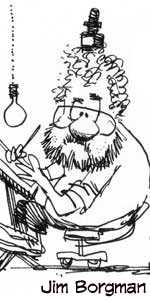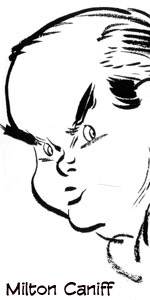| Cartoonists’ Mugging Themselves
—Thomas Carlyle
A Gallery of Rogues:
Cartoonists’ Self-Caricatures
Pictures
by the cartoonists; biographical text by Robert C. Harvey |
||||
| The
careers of the cartoonists whose mocking self-images appear in this
volume span more than a century of American cartooning. From the earliest
to the latest—from Thomas Nast and Fontaine Fox to Signe Wilkinson
and Scott Adams; from the most famous to the lesser known—from Charles
Schulz and Chester Gould and Walt Kelly and Lynn Johnston to Peter
Newell and Sol Hess and Nate Collier. Arranged by the genre practiced,
the self-caricatures are accompanied by mini-biographies penned by
yrs trly, R.C. Harvey. Over 150 gleeful self-portraits appear in the
book’s 160 pages (16 of which are in full, glorious color). Mark Cohen’s is the face behind the laughs in this book:
the cartoonists’ self-caricatures that appear in A Gallery of Rogues
are all from the Mark Cohen and Rosemarie McDaniel Collection of original
cartoon art. Mark estimated that they had about 6,000 pieces of original
art in the collection. It is really a goldmine for fans of cartoons. It is a cartoon fan's dream come true: 6000 pieces! I’ve been in his house, and I think he’s right:
cartoon artwork was lying around everywhere that it was not piled
up, leaving not much room in the house for Mark and his wife, Rosie.
Of the 6,000 pieces, around 600 are self-caricatures of cartoonists,
a lot of which appear only in copies of books of the cartoonists’
works that are inscribed to Mark and Rosie. So the 150-plus caricatures that appear in this
slim volume are just a taste of the iceberger (as we say in these
titanic times). But they are
the pick of the litter (if I may mulch the metaphor a little).
They are also the outward and visible sign of Mark’s love
of cartooning. At the beginning (which, for our purposes, is 1956 when
Mark was about fourteen), he wanted to be a cartoonist. And one day,
he took samples of his work to show them to a real cartoonist, hoping
to get advice on how to proceed with his career. Bert Whitman, who
was then editorial cartoonist for the Stockton Record, was
Mark’s mark. “It took me weeks to get up the courage to call,” Mark remembered,
“and when I finally made the appointment, I was scared to death. When
the day finally came, I went to the paper and was ushered into his
office. Whitman was a big moose of a man. He seemed like a giant to
me. I remember that he was working on the day’s cartoon, and he held
a soft-lead pencil in one hand and an art gum eraser in the other.
The hand holding the pencil would spiral down the sheet of coquille
board and the other hand would work the eraser,” Mark continued, demonstrating
by moving both hands at once. “I was awestruck, watching him work
with both hands, sketching and erasing at the same time, spiraling
down the paper.” Whitman looked at Mark’s cartoons and gave him some advice.
He also gave the youth his first original cartoon. Mark gave up his cartooning ambition because he didn’t fancy
the solitary life that cartoonists invariably lead. A highly gregarious
sort, Mark needed to be with people. So he elected to become a magician,
developing his act and an accompanying line of comedic patter. To
make a living, he was eventually driven to sell real estate. But the
comedian lived on: as he met cartoonists, he started writing material
for them, beginning with Morrie Turner and Wee Pals. In the
last analysis, though, it was Whitman who had persuaded him to give
up being a cartoonist: “I couldn’t spiral down the paper,” Mark said
with an impish grin. But he still loved cartooning. Passionately. And there was
something about the drawings in their original state that enthralled
him. He had been dazzled by the original cartoons hanging on the wall
in Whitman’s office. A habitué of used-book stores and antique shops,
Mark found some original cartoons in a Los Angeles shop, and he bought
some of them. The passion was fueled. The collection was born. Visiting a second-hand bookstore in 1971, he found a catalogue
from a 1943 exhibit in San Francisco at the deYoung Museum called
Meet the Artist. “It was
a book of self-portraits,” Mark said, “and it had Thomas Hart Benton
in it and the better known artists of the day, but it also had a number
of cartoonists who had done self-caricatures. It had Al Capp, Otto
Soglow, Zack Mosley, and so on. And it just really hit me. I thought,
How interesting. How fun it would be to collect self-caricatures.
Where would you find self-caricatures to collect? I had no idea. So
the logical thing to do was to make requests of the cartoonists for
self-caricatures. And I believe the first one that I asked was Al
Capp. I wrote to him. And one came back. And I became a self-caricature
requesting maniac.” Initially, he went after the self-caricatures he found in
the deYoung catalogue. And then he began looking for self-caricatures
of the cartoonists whose original art he had in his collection; pairing
the cartoon with the cartoonist’s self-caricature made an interesting
display. And display them he did. As the collection grew, Mark offered
it to museums around the country. When the exhibition consisted entirely
of self-caricatures, Mark called the show “The Face Behind the Laugh.” Indulging his life-long love of Mad magazine, Mark
began to acquire original art for the cartooning that had been published
in Mad. This niche of the collection grew until it embraced
nearly two hundred pieces, including cover paintings and such objets
d’art as Alfred E. Neuman coffee mugs and wrist watches. When
the Mad art goes on the road, it is displayed under the heading
“Humor in a Jugular Vein.”Among the self-caricatures herein are several
of the “usual gang of idiots” (as the Mad men call themselves). For this volume, Mark and I picked cartoonists whose life’s
works would be most familiar to the average citizen, but we also chose
some whose pictures of themselves were particularly noteworthy examples
of their artistry. The book is organized by genre, with sections devoted to
newspaper comic strip and panel cartoonists, followed by editorial
cartoonists, then Mad cartoonists, magazine cartoonists (those
whose work appears mostly in The New Yorker and then those
who are published in a variety of periodicals), then, bunched together,
caricaturists, animators, and illustrators of greeting cards, books
and advertising; finally, a section on comic book cartoonists. Those
in the color section come from all genres. And the genres of cartooning
trace the history of the medium. But the brief history and abbreviated
biographies herein are the bonuses; in the center ring is the hilarious
spectacle of the cartoonists’ mugging themselves throughout.
—R.C. Harvey |
||||
|
Art of the Comic Book - Accidental Ambassador Gordo - reviews - order form - return to main page - Rants & Raves - Harv's Hindsights |




